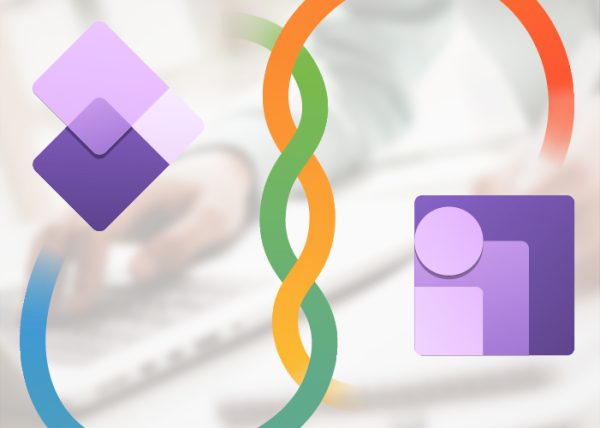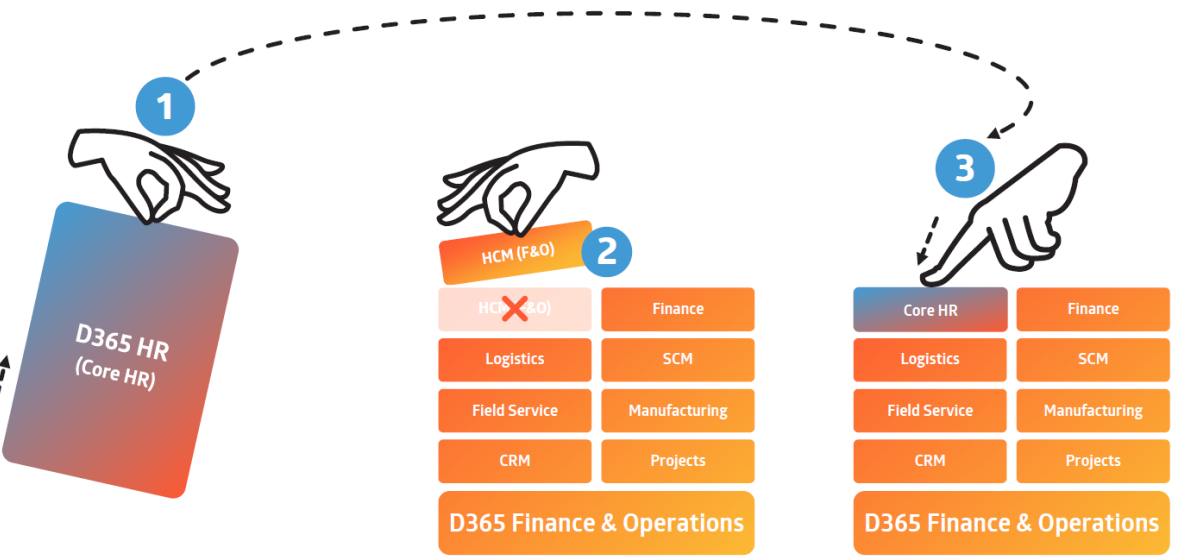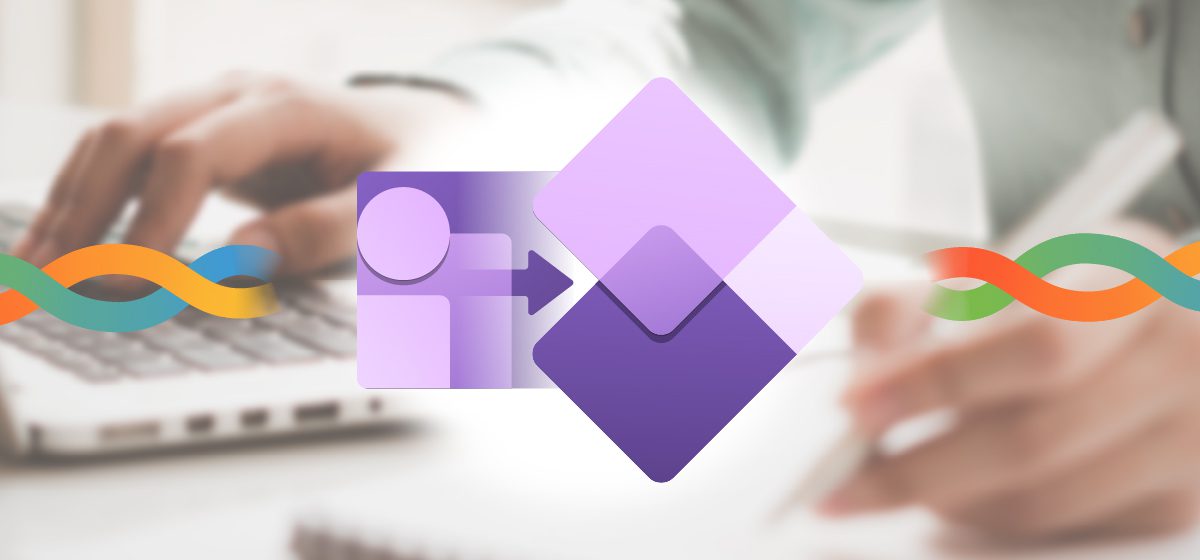
Let's get started with your D365 HR ▹ F&O Merge
Microsoft has migrated the standalone version of Dynamics 365 Human Resources to the Dynamics 365 Finance & Operations infrastructure, meaning that Dynamics 365 HR customers will have to migrate their HR-environment to the F&O platform before the end of 2023.
Read our answers to common FAQs on the upcoming merge below to find out more, or book a free knowledge session to discuss your unique situation. We’re happy to help all Dynamics customers with the migration process!
Infrastructure merge: What you should know
- Microsoft has released automated migration tools, which makes it possible to migrate Dynamics 365 HR to Dynamics 365 F&O by yourself;
- However, custom functionality and integrations require preparation, manual migration and potential reconfigurations.
- Customers have expressed their concerns about this, which is why we are setting out to make the migration or merge as simple as possible for you, as a service.
Determine which scenario applies to you
Scenario 1: Just Dynamics 365 Human Resources
You are currently using Microsoft Dynamics 365 Human Resources.
- Only the ‘Lift & Shift’ migration is required. Simple as that!
- Data, licenses and additional integrations will be moved to a new D365 F&O instance.
- All existing functionality will be preserved, and you will have the option to enable functionality that is native to F&O.
- The deadline for the migration to the F&O infrastructure before 2024 at the latest.
Scenario 2: Both Dynamics 365 HR and Finance & Operations
You are currently using both Microsoft Dynamics 365 Human Resources and Finance & Operations.
- Like scenario 1, the Lift & Shift migration of D365 HR to an empty F&O instance is required.
- The migration will leave you with two F&O instances:
- The one that was already in place for Finance, which remains unchanged;
- The new instance which is only used for HR.
- Based off this, you can choose to maintain two environments, or merge them into one.
Merge or migration, we can help!
While the migration of Dynamics 365 HR is free and partly automated with Microsoft’s tooling, some planning and other preparations are required to produce the desired result, such as:
- How to deal with URLs;
- Custom integrations;
- Custom fields;
- Power BI reports.
Whether you want to migrate or merge, we are ready to assist. Book a free knowledge session below, and we will discuss your situation and options.
If you want to learn about the details of the merge, make sure to to read the FAQ.
- Analysis of your solution: Take stock of current environment, (custom) integrations and (custom) connections;
- Make the right choice together: We will decide together which type of move will be used. We will handle the planning and migrations.
- Set up the right messaging/communication: Preparing the team for the new system is critical. We will give tips on handling
- Test the migration: We will help you test your migration and (new) integrations.
- We will report your Production Ready to Microsoft: Your Production Ready will be reported to Microsoft in order to audit and enable the migration.
Any questions? Book your free knowledge session here
Get the full picture
FAQ
Microsoft D365 HR is being discontinued as a standalone solution and will instead be merged into D365 F&O by December 2023. The merge will mean that D365 HR’s features and functionality will be rolled into a single F&O app.
The merge is an infrastructural merge and not a product merge. This means that 1. in F&O, there is a split between Human Resources and Organizational Management and 2. customers get to choose whether they want to keep a separate or unified (employee) database.
The merge forms part of Microsoft’s wider ‘One Dynamics One Platform‘ (ODOP) initiative that’s focusing on the convergence of F&O with the Microsoft Power Platform. This will enable customers to take full advantage of all business applications within D365 and the Power Platform.
Utilizing the cross-platform capabilities of F&O, users will benefit from an all-around better user experience with better administration, fewer barriers, and tightened integrations.
Some of the main benefits associated with the upcoming infrastructure include:
- More consistency between different D365 applications
- More scope for customization and integrating third-party add-ons
- More control for organizations using the HR module in F&O
Yes. All users of D365 HR must migrate to D365 F&O before the December 2023 deadline. The standalone D365 HR solution will no longer be supported after this date.
Although migrating is mandatory, merging the two is optional; organizations can choose whether to merge their HR and F&O databases into one or continue operating them separately.
You can learn more by reading our recent article,
Dynamics 365 HR to F&O merge: What, why, when, and how?
‘Migration’ refers to the act of moving from the standalone D365 HR solution to the new D365 F&O infrastructure. This is the easy part whereby data and licenses are migrated via a simple ‘Lift & Shift’ process.
‘Merge’ is an additional, optional step for D365 users that want to merge HR and F&O in the same environment. You can learn more by reading our recent article,
Dynamics 365 HR to F&O merge: What, why, when, and how?
All D365 HR-F&O merges begin with a ‘Lift & Shift’ migration that involves three key steps:
- Planning and preparation.
- Initiating the automated migration via Lifecycle Services.
- Deciding whether to merge your two F&O environments or keep them separate.
We highly recommend involving a D365 implementation partner like FourVision to help you make the most of it.
If you’d like to learn more, read our recent article where we explain these steps in more detail: How to get started with your Dynamics 365 HR-F&O migration
Microsoft released its migration tooling in December 2022. As such, we expect the migration deadline to fall in December 2023. Users should look to move to F&O infrastructure before 2024 at the latest.
The duration of your merge depends on your situation. According to Microsoft, the automated migration via Dynamics Lifecycle Services should take no longer than four hours depending on data volume.
This doesn’t account for custom integrations, however. Users operating a Dynamics deployment with custom integrations should work with a preferred partner to assess their migration readiness to ensure a successful move.
Although the migration itself is automated and costs nothing, some technical preparation is required. The cost of this will depend on your individual migration scenario.
D365 users that decide to undergo a merge on top of their migration should carefully plan and execute a manual data migration and involve their preferred partner to oversee the process.
If you’re a FourVision customer, you can of course contact us so that we can assess your situation.
All FourVision Web Apps have been updated to work with either D365 HR or F&O. All that’s required post-migration is a minor reconfiguration and you’ll be good to go.
If you’re a FourVision customer and you wish to merge D365 HR and F&O, feel free to get in touch. We’ll work with you to assess your situation and decide how to proceed.
No! One of the great things about the upcoming migration is that all D365 HR functionality will be carried over to F&O.
You won’t lose any data, either, assuming that your data migration is carried out correctly. Again, you should involve your preferred partner to ensure that this goes smoothly.
- User experience – Staff who have been trained on D365 HR will find the D365 F&O interface to be slightly different. We recommend training your HR users on F&O pre-migration.
- Business impact – Listen to the podcast below for more information directly from Microsoft, or read our recent article, Microsoft Dynamics 365 HR to F&O merge: business impact.
New Dynamics 365 HR customers can simply start using the HR module inside F&O. This has the same functionality as the standalone HR application. Even better: Microsoft will be releasing product updates on the merged infrastructure rather than the standalone HR app.
Existing D365 HR customers fall into one of two groups:
- D365 HR customers, where only HR is in use; and
- D365 HR and F&O customers, where both HR and F&O are in use (e.g., where Finance uses F&O and HR uses standalone D365 HR).
You’ll need to make careful preparations for the merge if you fall in group 2 because HR databases differ in each system. Have a read of our recent article, Dynamics 365 HR to F&O merge: What, why, when, and how? to find out more.
Licenses are automatically transferred and D365 HR customers will have access to their new F&O environment based on their license.
Technically, yes.
It’s highly recommended that you involve your preferred partner to assist you, however, especially if you use any custom integrations.
Don’t hesitate to contact us for a helping hand!
Microsoft began providing automated tooling for D365 HR users in December 2022. If you’re eligible, you can initiate a new project in your Lifecycle Services area.
As of 7 December 2022, Migration tooling for the D365 HR Infrastructure Merge is Generally Available (GA).
According to Microsoft, the current file-based integration between Ceridian Payroll and Dynamics 365 HR will not be migrated.
FourVision offers a Payroll Interface Web App to integrate any major payroll provider with the Dynamics 365 platform.




